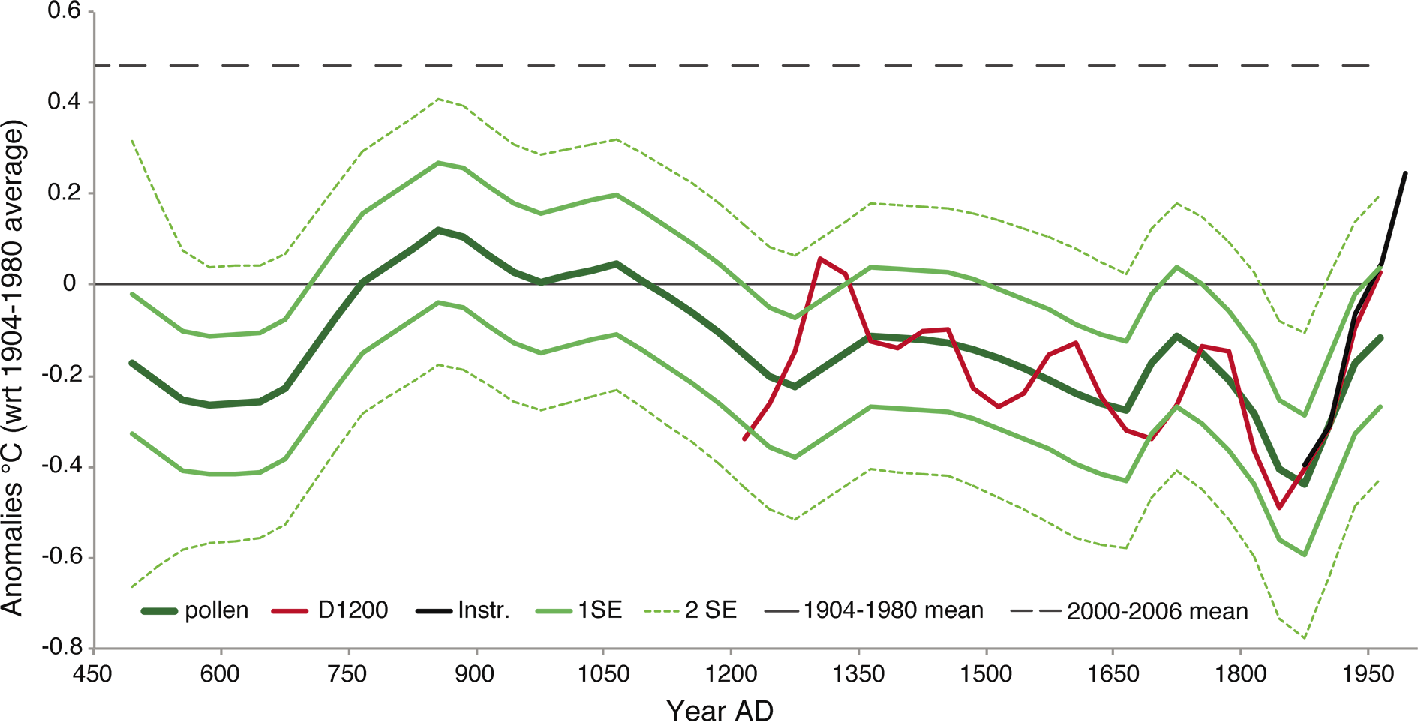- Home
- Publications
- PAGES Magazine
- A Pollen-based Extension of The 800-year Decadal-scale Reconstruction of Annual Mean Temperature For Temperate North America Dating Back To 480 AD
A pollen-based extension of the 800-year decadal-scale reconstruction of annual mean temperature for temperate North America dating back to 480 AD
Valerie Trouet, H.F. Diaz, A.E. Viau, E.R. Wahl
PAGES news
20(2)
87-88
2012
Valerie Trouet1, H.F. Diaz2, A.E. Viau3, E.R. Wahl4
We present a tree-ring and pollen based mean annual temperature reconstruction for temperate North America (480-1980 AD) that shows two prominent low-frequency periods: the warmer Medieval Climate Anomaly (750-1100 AD) and the cooler Little Ice Age (1300-1850 AD).
The PAGES 2k Network initiative aims to reconstruct climate variables for the last 2000 years. In a parallel effort, the NAM2K group produced an 800-year (1200-1980 AD) decadal scale annual mean temperature reconstruction using a network of tree-ring records in western North America (Wahl et al. 2012a, this issue; Wahl and Smerdon 2012). That reconstruction is referred to henceforth as D1200 (for decadal 1200). Here we present a pollen-based 30-year resolution mean annual temperature reconstruction for the temperate region of North America (30˚-55˚N, 95˚-130˚W) extending D1200 back to 480 AD. In the following, we describe the methodology used for this reconstruction and briefly compare it with other regional temperature reconstructions.
We performed a principal component analysis (PCA) using four North American regional pollen-based temperature reconstructions (Viau et al. 2012); specifically those based on pollen sequences from deciduous, hardwood, boreal, and mountain ecoregions of North America. The prairie ecoregion reconstruction for the center of Northern America was not used as its vegetation is mainly controlled by precipitation (Viau et al. 2012). Mean annual temperature reconstructions were used instead of summer temperature anomalies as in Viau et al. (2012) for a more direct comparison of the pollen reconstructions to D1200. The resulting 30-year PCA scores (360-1950 AD; n=54) were then included in a stepwise multiple linear regression against the D1200 curve. For this purpose, D1200 was smoothed using a ~110 year lowess filter and sampled every 30 years to conform with the time scale and sampling resolution of the pollen-based reconstructions. Three combined PC axes explaining 87% of the common variance in the pollen reconstructions were retained in the stepwise regression and explained 33.4% of the variance (corrected for autocorrelation) in D1200.
Uncertainty was estimated based on the 1 and 2 standard error (SE) limits for the pollen-based reconstructions and the SE of the regression model. The SEs for the pollen-based reconstructions were developed using a Monte Carlo resampling technique that generated random sequences by sampling values at each time step of the individual pollen series within each series' uncertainty limits. This process was repeated 10,000 times to generate the pollen-based reconstruction uncertainty bands. These were then inputted into the previously developed PCA and multiple linear regression equations to determine the component of the overall 1SE and 2SE uncertainty limits that is inherent in the pollen-based reconstruction method. The pollen-based reconstruction 1SE and 2SE limits estimated in this manner were augmented with the corresponding regression 1SE and 2SE values at each time step, by adding the squares of the errors and taking the square root of the sum. Because estimated uncertainties were unrealistically high prior to 480 AD, we truncated our temperature reconstruction at this date.
Comparison between D1200 and the pollen reconstruction is quite reasonable (Fig. 1). Except for a peak around 1300 AD, the smoothed D1200 falls nearly entirely within the 1SE uncertainty envelope. The overall amplitude of change for the entire period is ~±0.55°C and thus falls within the range of amplitudes found for hemispheric-scale temperature reconstructions over the last millennium (0.4-1°C, see Esper et al. 2012). The start date of our reconstruction is too recent to capture warmth during Roman times (0-400 AD) and this is likely one of the reasons why a millennium-scale cooling trend, caused by orbital forcing, is not as evident as in high-latitude temperature reconstructions for the same period (Kaufman et al. 2009; Esper et al. 2012).
There are three prominent low-frequency periods in the North American extended reconstruction, notably the cooler Dark Ages (ca. 500-700 AD), Little Ice Age (ca. 1300-1850 AD), and warmer Medieval Climate Anomaly (MCA; see also Wahl et al. 2012b). Our results show that the MCA, here between ca. 750 and 1100 AD, was slightly warmer than the baseline period (1904-1980 AD), but much cooler than the early 21st century (Fig. 1). The MCA shows peaks around 850 and 1050 AD. Following the MCA, mean annual temperatures decreased until the mid-19th century, after which temperature began to increase rapidly. Our reconstruction shows similarities with other long temperature reconstructions, not only at the centennial scale (e.g. cold Dark Ages in Büntgen et al. 2011), but also at the decadal scale. Warmth in the mid-11th century and cool 17th and 19th centuries, in particular, are well replicated in multiple hemispheric-scale temperature reconstructions (e.g. Frank et al. 2010; Mann et al. 2009; Moberg et al. 2005).
affiliations
1Laboratory of Tree-Ring Research, University of Arizona, Tucson, USA; trouet email.arizona.edu
email.arizona.edu
2Cooperative Institute for Research in Environmental Sciences, University of Colorado, Boulder, USA
3Department of Geography, University of Ottawa, Canada
4National Climatic Data Center, National Oceanic and Atmospheric Administration, Boulder, USA
selected references
Full reference list online under: http://pastglobalchanges.org/products/newsletters/ref2012_2.pdf
Esper J et al. (2012) Nature Climate Change, doi: doi:10.1038/nclimate1589
Kaufman DS et al. (2009) Science 325: 1236-1239
Viau AE, Ladd M, Gajewski K (2012) Global and Planetary Change 84-85: 75-83
Wahl EW, Diaz HF, Trouet V, Cook ER (2012a) PAGES News 20(2): 86-87
Wahl ER, Smerdon JE (2012) Geophysical Research Letters 39, doi: 10.1029/2012GL051086


